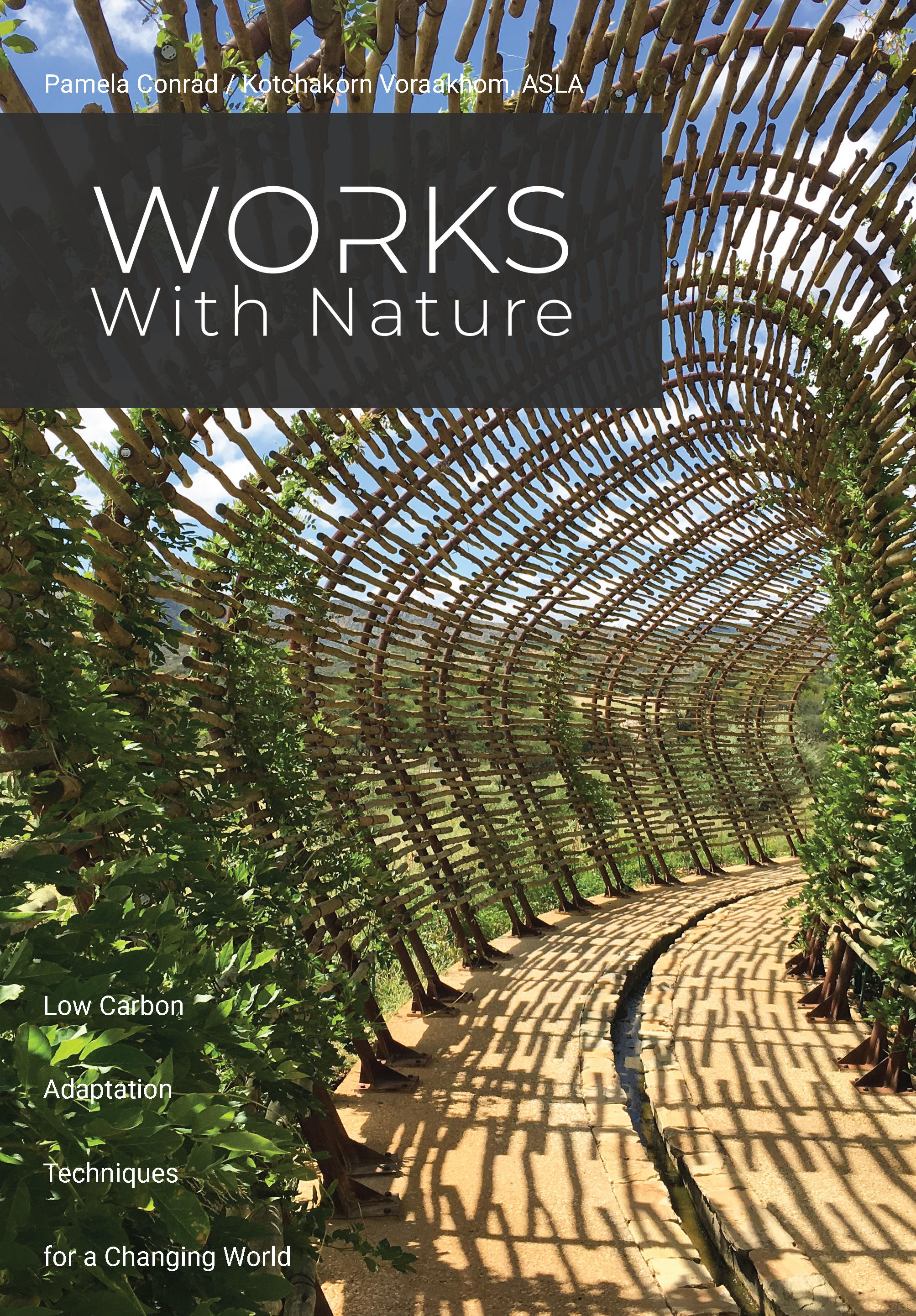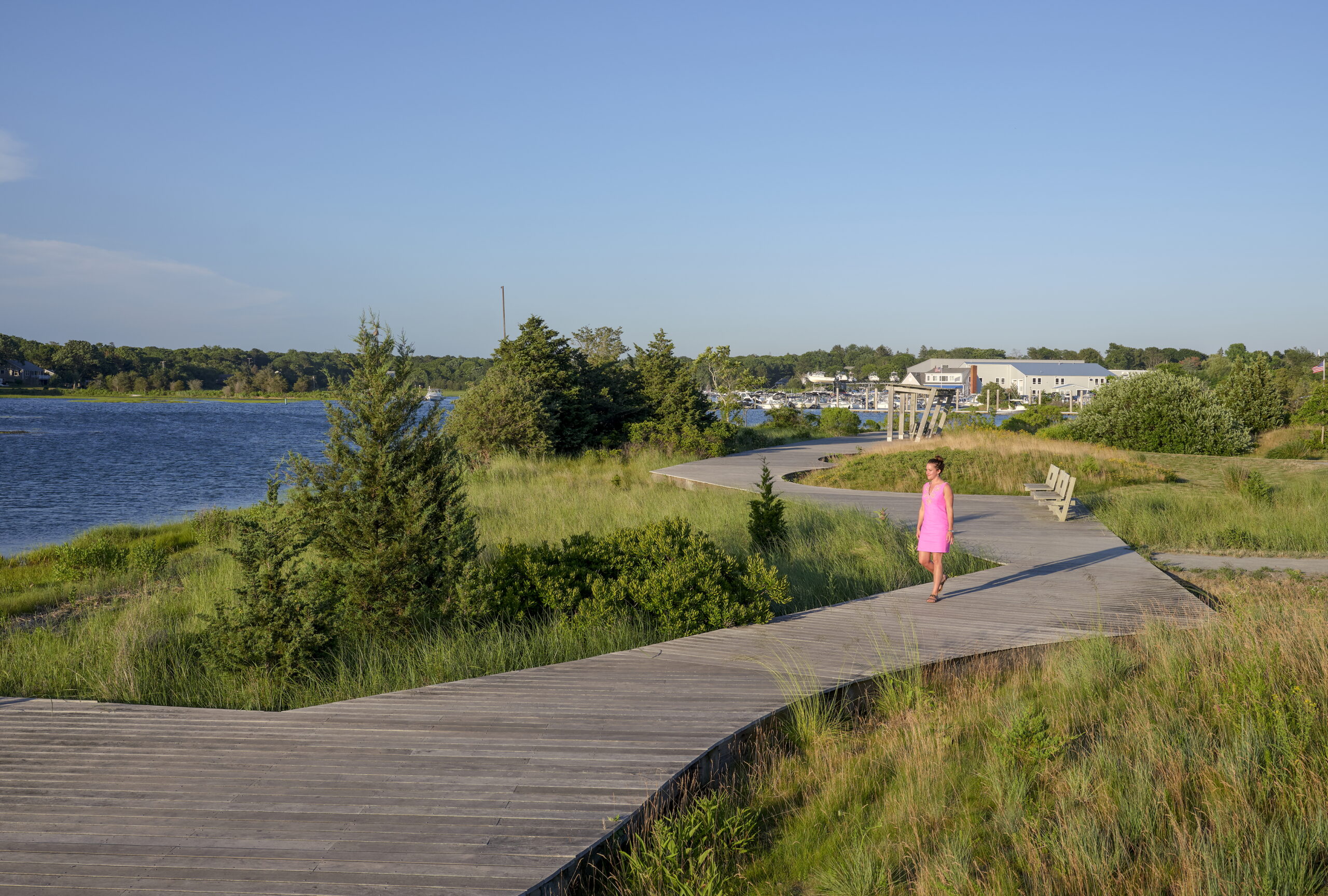Kira Gould, a Senior Fellow with Architecture 2030, conducted this interview. Architecture 2030’s mission is to rapidly transform the built environment from a major emitter of greenhouse gases to a central source of solutions to the climate crisis. For 20 years, the nonprofit has provided leadership and designed actions toward this shift and a healthy future for all.
Even casual observers of the built environment climate action scene and COP have likely noticed the significant uptick over the past several years in discussing nature-based solutions. Fortunately, this has occurred as the built environment community has been developing a broader understanding of what constitutes the built environment. As Architecture 2030 has put it, this goes far “beyond buildings.” We are talking about sites, landscapes, and infrastructure – and we are talking with landscape architects, planners and urban designers, too.
Two preeminent landscape architects in this movement within a movement — Pamela Conrad and Kotchakorn Voraakhorn — led the development of WORKS with Nature: Low Carbon Adaptation Techniques for a Changing World. This guide, released late last year, was developed for the UN Framework Convention on Climate Change by Climate Positive Design and Porous City Network, with support from the American Society of Landscape Architects, the International Federation of Landscape Architects, and sponsors Vestre and Landscape Forms.
This practical guide is meant to turn the buzz into action. I talked with Pamela and Kotch about the guide, the immense potential of nature-based solutions, and why this matters right now.
ASLA 2021 Professional General Design Honor Award. From a Concrete Bulkhead Riverbank to a Vibrant Shoreline Park—Suining South Riverfront Park. Suining City, Sichuan Province, China. ECOLAND Planning and Design Corp. / Arch-Exist Photography
Kira Gould (KG): Now that so many talk about nature-based solutions, why did you decide it was time for a practical guide to show designers how to deploy these strategies?
Pamela Conrad (PC): In recent years at COP and other international events, I’ve heard more and more discussion about nature-based solutions. I have also noticed a disconnect. While people talk about these solutions enthusiastically, few seem to thoroughly understand precisely what they are. For instance, people commonly mention mangroves. They are not wrong, but these solutions are so much more.
Nature-based solutions work with natural ecosystems to address pressing challenges like climate change, biodiversity loss and social inequities. They can be implemented in urban and rural areas and at any scale of development.
These solutions include restoring wetlands to manage flooding, integrating green roofs in cities to reduce heat, and creating sustainable urban forests to improve air quality. The brilliance of these solutions lies in their multifaceted benefits. They deliver environmental, economic and social advantages simultaneously.
When people see these strategies in action, it can be a revelation. Suddenly, the abstract concept becomes tangible. For instance, when attendees at past COP events saw how these solutions could transform landscapes, enhance community resilience, and reduce costs, their enthusiasm shifted into action.
This was the inspiration for launching WORKS with NATURE: Low Carbon Adaptation Techniques for a Changing World at the conference. It serves as a supplement to the UN National Adaptation Plan Technical Guidelines.

The WORKS with NATURE guide highlights one hundred low-carbon adaptation techniques from around the world. / GREENinc landscape architecture, South Africa
KG: Why is this guide essential for developing countries?
Kotchakorn Voraakhorn (KV): The stakes are high. We are those who are affected the most. In another way, the opportunity is tremendous. However, while developing countries have done the least to cause climate change, places like my home in Bangkok, Thailand, are facing the highest risks. The guide features nature-based solutions that can be implemented anywhere in the world. The case studies are from around the world, not only the Global North. While showcasing 100 solutions from both developing and developed countries, it was our goal to break down silos of knowledge sharing.
KG: Who is the guide for, and how should they use it?
PC: This guide is for practitioners, property owners, community members, municipal leaders, developers, and policymakers. I say practitioners first because it is full of meaningful case studies that show how nature-based solutions can work. But all those other audiences are important, too — we all have a stake in how our communities are being built and how resilience and climate response are being addressed.
The document is organized by global challenges, from heat, fire, and drought, to flooding, biodiversity loss, and food security, all with a lens of low-carbon design. It reads like a “choose your own adventure”, to focus on the strategies most relevant to you.
Each solution includes lessons learned, details on what makes it unique, and a technical drawing with images.

Bass River Park, Cape Cod, Massachusetts. STOSS Landscape Urbanism / Copyright MILLICENT HARVEY
KG: Can you share some context about why this is so critical now? What is ahead for adaptation and mitigation and how can nature-based solutions have value compared to conventional infrastructure choices?
PC: An estimated 75 percent of the infrastructure we will rely on in 2050 has yet to be built. Meanwhile, an estimated 800 million people will be vulnerable to coastal flooding by mid-century without adaptation measures. Traditional infrastructure, built primarily with concrete and steel, is costly and carbon-intensive, contributing to the climate crisis we’re trying to solve.
We can shift from traditional gray infrastructure to nature-based solutions, which often cost significantly less and emit a fraction of the greenhouse gases. The return on investment is roughly fourfold for every dollar spent on these solutions, thanks to benefits like flood mitigation, cleaner air, and increased biodiversity. According to estimates by The Nature Conservancy, these solutions could account for up to 30 percent of the carbon sequestration needed by 2030 to limit global warming to 1.5°C. These solutions make economic, environmental and social sense.
KG: What about funding and policy? What is the landscape there?
PC: The public and private sectors are projected to invest $90 trillion in significant infrastructure projects by 2030, presenting an unprecedented opportunity to integrate nature-based solutions into the foundation of future development. However, less than 10 percent of current adaptation funding goes to green infrastructure, despite its lower costs, around 70 percent less than traditional gray infrastructure.
KV: To bridge this gap, we cannot wait for policy; we need to take action now with innovative financing mechanisms and consistent performance evaluations to demonstrate these solutions’ effectiveness and economic benefits ASLA’s recent briefs on the economic benefits of nature-based solutions are just the start of an ambitious economic research agenda that will support increased investment. Collaboration between policymakers, landscape architects, and communities will be key to scaling up these solutions and ensuring that nature is central to building a sustainable future.
The path forward is clear: let’s invest in nature to secure a resilient, equitable, and thriving world for future generations.
Architects: Want to have your project featured? Showcase your work by uploading projects to Architizer and sign up for our inspirational newsletters.

